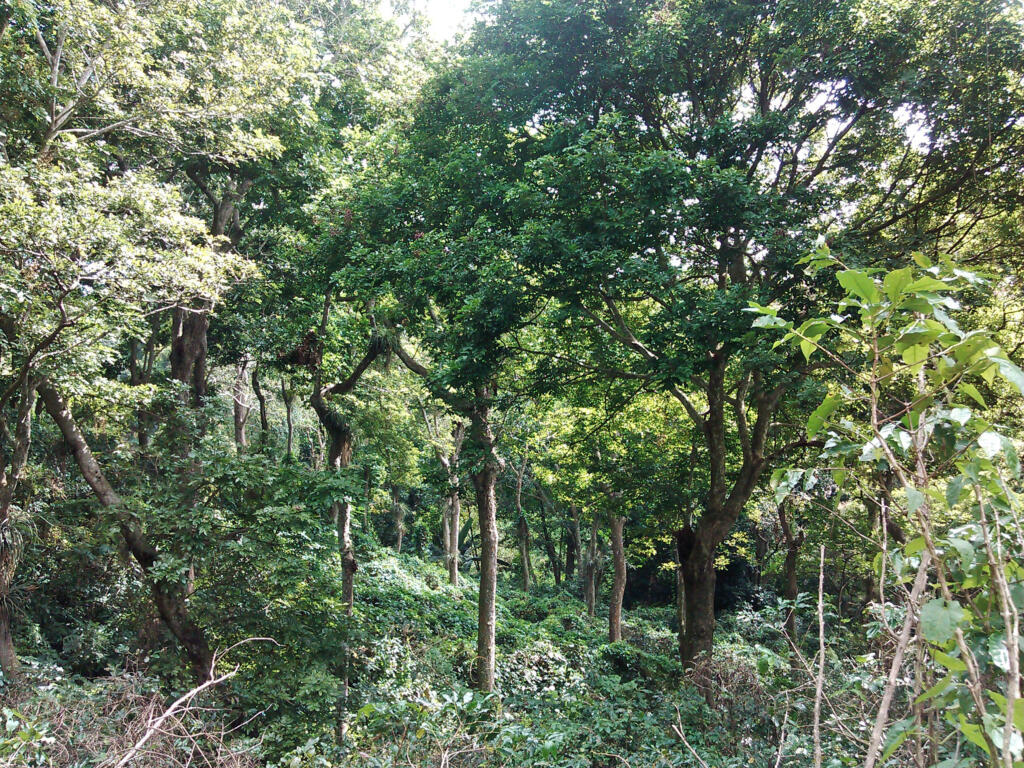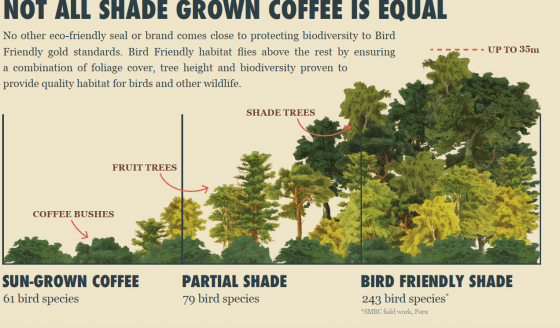In recent years, coffee has become synonymous with all things ethical. Many consumers search for good products for themselves and the world, leading to a boom in niche markets such as organic, fair trade, and, most recently, shade-grown coffee.
Coffee is typically grown in one of two ways — either it’s grown in full sun, or it’s grown under the shade of a natural canopy.

Both methods have pros and cons, but when it comes to taste, most connoisseurs agree that shade-grown coffee produces a less acidic and more nuanced final product. But what exactly is shade-grown coffee? And why should you care? Let’s take a look…
What is shade-grown coffee?
As the name suggests, shade-grown coffee is partially or entirely grown in the shade (under the canopy of trees. Coffee plants naturally grow and thrive under a forest roof.
When fully matured, coffee plants are the height of an average adult and small enough to thrive under the tall trees surrounding them in a tropical climate. As a result, they look like a beautiful, waxy green bushes.
This coffee is traditionally grown in regions where the coffee plants naturally grow and thrive in the shade. The tall trees provide a canopy that filters carbon dioxide and helps to prevent global warming. Shade-grown coffee also requires little or no chemical fertilizers, pesticides, or herbicides.
The History of Shade-Grown Coffee
Shade-grown coffee is a type of coffee grown under the shade of trees. It is a more traditional way of growing coffee and has many benefits over sun-grown coffee. Shade-grown coffee farms are more ecologically diverse and provide better bird habitats. Shade-grown coffee is also more sustainable, as it does not require the clear-cutting of forests.
Shade-grown coffee has a long history. Coffee plants naturally grow in the shade, which was how coffee was traditionally grown. However, sun-grown coffee has only been around since the mid-1970s, and it has proven to be an unsustainable micro-ecosystem that necessitates constant fertilization and pesticide use.
This is great for fertilizer and pesticide manufacturers but terrible for farmers and the environment.
This led to the clear-cutting of forests to create sun-grown coffee plantations, negatively affecting the environment. In recent years, a movement has been transitioning back to traditional shade-grown coffee to help reforest areas cleared for sun-grown coffee plantations.
Does shade-grown coffee taste better?

Does shade-grown coffee taste better?

Yes, compared to sun-grown coffee, shade-grown coffee is superior. The quality of shade-grown beans is excellent. They are high-quality tropical coffee beans that guarantee enough nutrients for every cup of joe.
If you doubt shade-grown coffee tastes better than sun-grown coffee, you are welcome to enjoy both and share your experience. But remember to let me know which tastes better.
Shade-grown coffee benefits vs. sun-grown defects

Besides the high-quality taste that makes shade-grown coffee superior, other qualities prove its quality coffee.
Shade-grown coffee has more nutrients. -However, sun-grown coffee is exposed to the brutally hot sun, which hurts its level of nutrients. This means you get fewer nutrients for every cup of sun-grown coffee beans. In addition, chemicals like fertilizers can be sprayed to boost the level of nutrients, which leads to non-organic coffee. Shade-grown coffee is fertilized by leaves dropping from tall trees.
Growing coffee under a canopy of trees has also been linked to coffee plants lasting longer than those grown directly under the sun. This is because the sun has been seen to unnaturally accelerate the lifespan of coffee plants.
What is shade-grown certified?
Compared to other structured movements like Rainforest Alliance, Fair Trade, and USDA Organic, shade-grown coffee is not, so there is no actual shade-grown coffee certification. Lack of an actual certification means no standards for the industry.
So, you may want to be very cautious when buying this coffee. You can check for Bird Friendly, USDA Organic, and Fair-Trade certifications to be sure you are buying the right coffee.
Bird-friendly coffee

As mentioned above, it is rare to find coffee with shade-grown certification. Luckily, you can look for coffee with bird-friendly certification, as they are the closest to shade-grown coffee you can get. Any coffee with this certification is organically certified, and the forest it grows in provides at least 40% shade for the coffee plants. So, make sure to check for this certification when shopping.
Where to find shade-grown coffee?
You will need more time to find the right shade-grown coffee.
Tiny Footprint Coffee is one place you can find quality shade-grown coffee.
Tiny Footprint Coffee
You can also check this site.
Wrap up
As you can see, shade-grown coffee is coffee that grows and thrives naturally under a forest roof. The undamaged and eco-friendly habitat results in high quality. However, when coffee beans give you the best brew. You may want to be cautious when shopping, as no actual shade-grown movement exists to regulate production and processing.
FAQ:
Is shade-grown coffee better?
Yes, it is. First, it is purely organic. No artificial chemicals were added. Second, the trees produce their crops more slowly, producing coffee beans with a superior flavor.
How many years can a coffee tree yield fruit?
On average, a However, coffee tree can produce fruits for 25 years. It takes four to five years for a tree to produce the first crop.
How much coffee does a coffee tree produce?
A coffee tree produces 1 to 1.5 pounds of coffee beans. It takes about five pounds to yield a pound of coffee.
Disclaimer: This post contains affiliate links, which means I may receive a small commission, at no extra cost to you, if you make a purchase using these links. Remember to support us by purchasing through the Amazon/Walmart/Impact Radius links provided. Last update on 2024-04-29 / Affiliate links / Images from Amazon Product Advertising API
Disclosure: No compensation or free products were received in exchange for writing this review.

Editorial Staff
The editorial staff at Crazy Coffee Crave is a team of coffee enthusiasts & Baristas who enjoy the one thing we all think about as soon as we get up in the morning. Trusted by thousands of readers worldwide.






